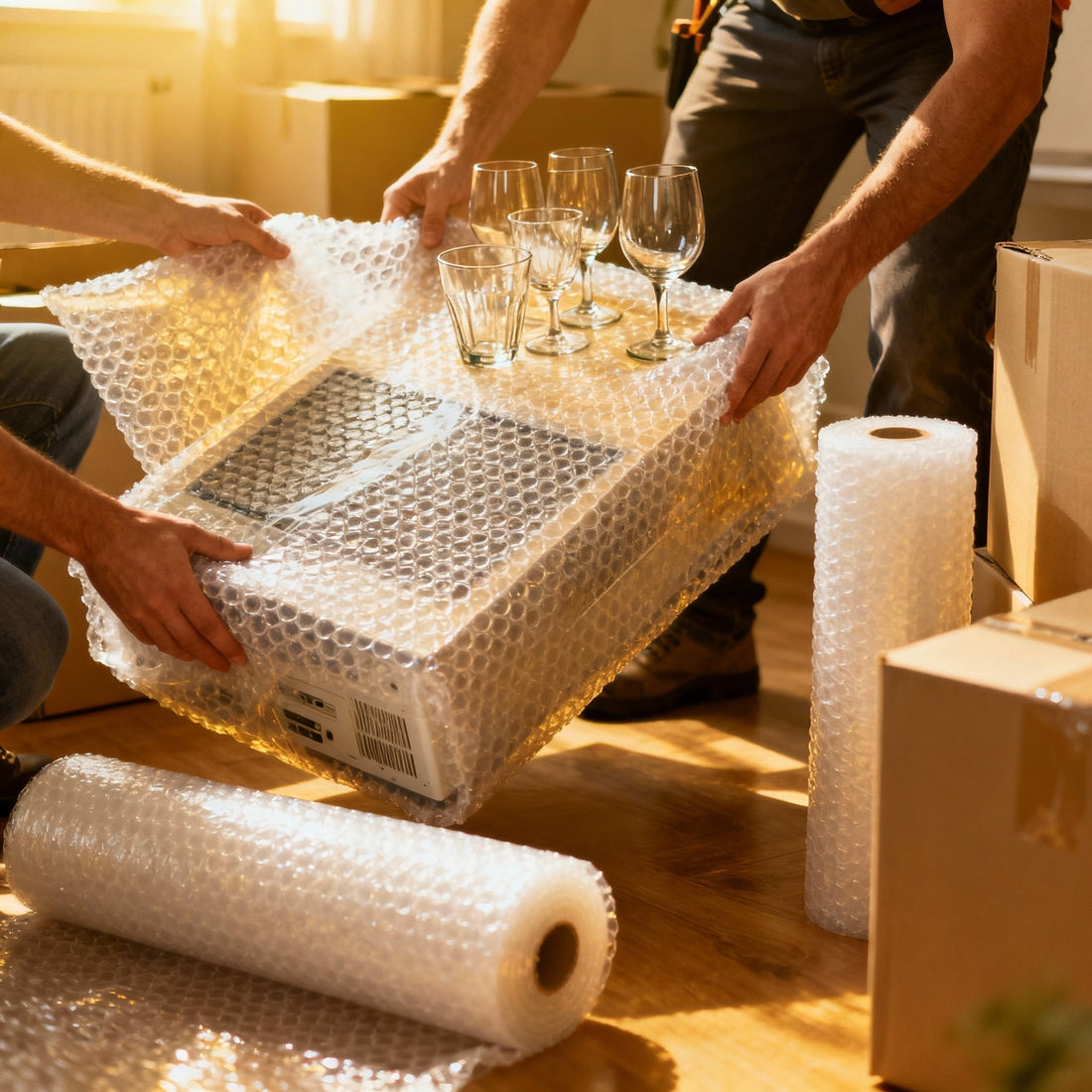Introduction: Why Packing Matters More Than You Think
Imagine this: you’re standing in the middle of your living room, surrounded by boxes and the chaos of an upcoming move. You want your belongings—fragile glassware, cherished family photos, your favorite mug—to arrive safely at your new place. But how do you ensure everything survives the journey? That’s where bubble wrap steps in as the quiet guardian of your valuables.
Bubble wrap may seem simple, but it’s one of the most important tools for protecting your belongings during a move. This article explores the fascinating world of bubble wrap: how it works, why it’s essential, how to use it effectively, and how to make sustainable choices—all so you can move with peace of mind.

The History of Bubble Wrap: From Wallpaper to Packaging Powerhouse
Bubble wrap wasn’t always destined for the moving van. In 1957, engineers Alfred Fielding and Marc Chavannes tried to create a new textured wallpaper by sealing two shower curtains together. The experiment didn’t lead to trendy home décor, but it revealed a surprising result: air-filled bubbles that provided exceptional cushioning.
Instead of wallpaper, their invention eventually became the world’s favorite packaging material. By the 1960s, bubble wrap was trademarked and marketed as a way to protect fragile IBM computers during shipping. The rest is history—bubble wrap became synonymous with safe, damage-free packaging around the globe.
How Bubble Wrap Works: The Science Behind the Bubbles
At first glance, bubble wrap looks like nothing more than a sheet of plastic dotted with air-filled bubbles. But don’t be fooled—there’s science at work in every pop.
Each bubble acts as a miniature shock absorber. When your box gets bumped or dropped, the air in the bubbles compresses, spreading out the force and protecting the item inside. It’s this “cushion of air” that makes bubble wrap so effective at reducing the risk of breakage for fragile items during shipping or moving.
The layers of bubbles also trap air, which insulates items from sudden temperature changes or humidity—especially important for electronics, artwork, or delicate antiques.
Why Bubble Wrap Is Essential for Moving
-
Protects Fragile and Valuable Items
Moving is unpredictable. Even with careful planning, boxes can be jostled, stacked, or accidentally dropped. Bubble wrap provides a reliable layer of defense for your most delicate possessions—glasses, vases, dishes, mirrors, electronics, and more. -
Reduces Stress and Saves Money
Nothing dampens the excitement of moving like discovering broken items in your new home. Bubble wrap minimizes this risk, letting you focus on settling in—not replacing cherished belongings. Investing in the right packing materials can actually save you money by preventing costly damage. -
Lightweight and Space-Efficient
Bubble wrap adds very little weight, so it won’t increase shipping or transport costs. It’s also flexible, allowing you to wrap items of all shapes and sizes, and fill empty spaces in boxes to prevent shifting. -
Versatile and Easy to Use
From wrapping individual plates to cushioning large furniture corners, bubble wrap is incredibly versatile. You can easily cut it to size, double up for extra protection, or use sheets, rolls, and pouches for specific packing needs.
Types of Bubble Wrap: Choosing the Right Option
- Small Bubble Wrap (3/16” bubbles): Perfect for protecting smaller, lightweight items like glasses, dishes, and electronics.
- Large Bubble Wrap (1/2”–1” bubbles): Great for cushioning heavier or larger items, such as vases, picture frames, or lamps.
- Anti-Static Bubble Wrap: Designed for electronics, this type prevents static electricity that could damage sensitive components.
- Self-Adhesive Bubble Wrap: Stays in place without tape, ideal for quick packing or wrapping odd-shaped items.
- Bubble Wrap Bags and Pouches: Pre-made sleeves for fast, secure protection of artwork, laptops, or flat items.
How to Use Bubble Wrap Effectively: Packing Like a Pro
-
Wrap Items Securely
Place items on the bubble side (not the flat side) and wrap them completely, overlapping edges to ensure no part is exposed. For especially fragile items, use two layers. -
Tape for Extra Security
Use packing tape to keep the bubble wrap in place—especially around plates, glassware, or electronics. -
Fill Empty Spaces
Line the bottom and sides of boxes with bubble wrap before packing. Fill any empty spaces with additional wrap to prevent shifting during transit. -
Protect Corners and Edges
Furniture, mirrors, and artwork are most vulnerable at the corners. Use extra bubble wrap or corner protectors to cushion these areas. -
Label Boxes Clearly
Mark boxes containing fragile, bubble-wrapped items as “FRAGILE” and indicate which side should face up to help movers handle them with care.
Bubble Wrap vs. Other Packing Materials: Why It’s Often Best
- Newspaper: Inexpensive, but can leave ink stains and offers less cushioning.
- Packing Peanuts: Good for filling spaces, but messy and less eco-friendly.
- Foam Sheets: Excellent for flat items, but less versatile for odd shapes.
- Clothing or Towels: Handy for extra padding, but can shift inside boxes and isn’t always clean.
Bubble wrap combines flexibility, lightweight protection, and ease of use—making it the gold standard for most moves.
Innovative Uses for Bubble Wrap
- Gardening: Use as insulation for outdoor plants or greenhouses in winter.
- Window Insulation: Temporarily insulate windows in cold weather by pressing bubble wrap against damp glass.
- Travel: Cushion souvenirs in your luggage to prevent breakage.
- Crafts: Kids love popping bubbles, but you can also use bubble wrap to create textured art!
Environmental Impact: Is Bubble Wrap Eco-Friendly?
Traditional bubble wrap is made from plastic, which means it’s not biodegradable. However, there are steps you can take to reduce your environmental impact:
-
Reuse Whenever Possible
Bubble wrap can often be reused for multiple moves or projects. Save sheets after your move for future shipping, storage, or crafts. -
Choose Recycled or Biodegradable Options
Many suppliers now offer bubble wrap made from recycled materials or biodegradable plastics. These options provide the same protection, with less environmental impact. -
Recycle Properly
Most bubble wrap can be recycled at special plastic film drop-off points (e.g., at supermarkets), but not in regular curbside bins. Check local guidelines to recycle responsibly. -
Use Only What You Need
Don’t overpack—use the right amount of bubble wrap for each item. Combine with other reusable materials when possible (such as towels or blankets for large items).
Frequently Asked Questions About Bubble Wrap and Moving
Q: Should I wrap dishes individually, or can I stack them?
A: Always wrap each dish individually with bubble wrap, then stack them vertically (like records) in a box lined with more wrap.
Q: Is bubble wrap safe for electronics?
A: Yes, but use anti-static bubble wrap for computers, TVs, and other sensitive devices.
Q: Can bubble wrap protect furniture?
A: Absolutely. Cover furniture corners, legs, and delicate surfaces to prevent scuffs and damage during the move.
Q: How do I store bubble wrap for reuse?
A: Roll sheets gently and keep them dry. Store in a large plastic bag or bin to prevent dust.
Tips for a Stress-Free Move with Bubble Wrap
- Start Early: Collect bubble wrap ahead of time so you’re not scrambling on packing day.
- Pack Fragile Items First: Use bubble wrap for glassware, ceramics, and electronics before packing sturdier items.
- Don’t Skimp on Corners: Most breakage happens at the corners and edges—double wrap these areas.
- Recycle After the Move: Either reuse, donate, or recycle your bubble wrap responsibly.
- Combine with Other Materials: Use towels or soft clothing for large, non-fragile items, reserving bubble wrap for what matters most.
Bubble Wrap Myths Debunked
“Bubble wrap is expensive.”
In reality, the cost of bubble wrap is small compared to the cost of replacing broken items.
“You only need bubble wrap for glass.”
Many items benefit from bubble protection, including electronics, collectibles, and even shoes or handbags.
“Bubble wrap can’t be recycled.”
While it’s not accepted in all recycling bins, most communities offer plastic film recycling options.
The Emotional Side: Peace of Mind During a Move
Moving is stressful—emotionally and physically. Bubble wrap offers more than protection for your possessions; it offers peace of mind. Knowing your grandmother’s vase, your child’s artwork, or your prized guitar is safely cushioned means one less thing to worry about. That feeling is priceless.
Conclusion: The Unsung Hero of Every Move
Bubble wrap might never win awards for glamour, but its role in a successful move can’t be overstated. It’s the invisible shield that stands between your memories and disaster, the soft layer that ensures your life’s treasures arrive safe and sound.
Next time you plan a move, don’t underestimate the importance of quality bubble wrap. Whether you’re packing a single room or an entire house, make it your go-to tool for reliable, worry-free protection.
And if you need high-quality bubble wrap, eco-friendly options, or expert advice on packing supplies, visit our website or contact our team. We’re here to help make your move smooth, safe, and as stress-free as possible.
Remember: When you pack with bubble wrap, you’re not just wrapping things—you’re wrapping up your worries and sending them safely on their way.





